#worldbuilding reference
Text
WorldBuilding Ask Game
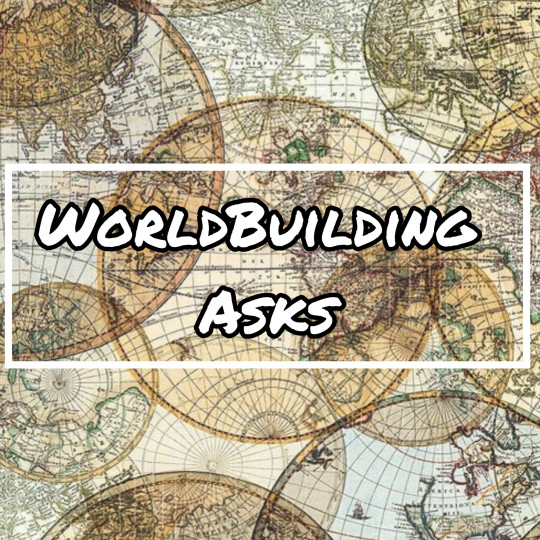
Here is a little ask game for WorldBuilding in your WIP to pad out one country or all of them! Use it for yourself or ask a friend and spread some love. Focus on a particular section and have fun!
Geography
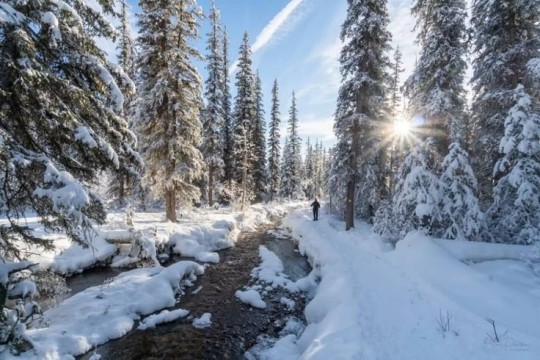
What does your world look like? What's the biome? Are there different ones?
Are there any oceans? If so, are they accessible? Are they a reliable source of travel and food?
Are there any rivers in your world? Any lakes? What's the longest river? Deepest lake?
Is there a safe supply of drinking water? If not, why not?
Are there mountains in your world? What's the highest one?
What is the weather like? How does this effect life?
What animals inhabit the world? What animals are indigenous or considered exotic?
What are some natural features your world is famous for? Is your world considered beautiful?
How many countries in your world?
How are countries divided? By natural lines or by agreements?
Population

What's the population like? Is it large or sparse?
Is there any factors in population density? Do more people live in a certain area more than elsewhere? Why is that?
Are there different peoples living in your world? If so, how do they get on?
How important is nationality? Are foreigners tolerated? Or are they unwelcome?
What countries get on? What countries hate one another?
Are there any important cities? Why are they important?
What's the architecture like? Are there any outside influences?
What's a typical building material? What's considered an expensive feature to include?
What is infrastructure like? Are roads and railways in good condition?
Is there public transport? Is it reliable?
Government
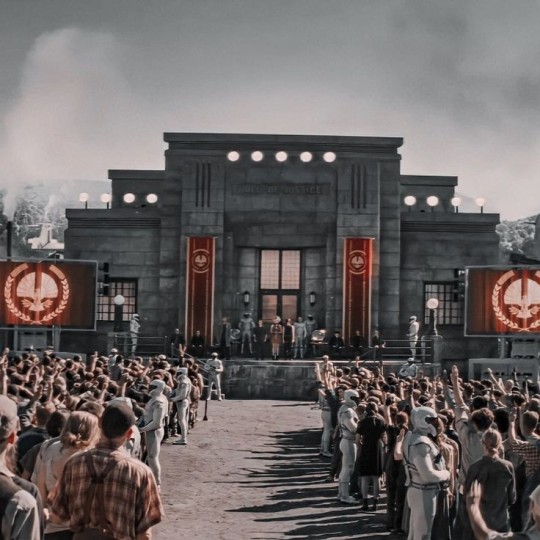
What system of government does your world adhere to? Is it popular?
Where is the seat of government?
Are there different governmental agencies?
Are there political parties? If so, what are their goals?
How much control does the government have over the average person?
Can your people vote? If not, why not? If so, who has/hasn't the right to?
Are there any parties or organisations that oppose the government?
How does the government crack down on sedition?
Are people allowed to criticise the government? If so, how? If not, how do they get around it?
How are laws made? Who makes them?
Is there any odd laws in your world?
What are some punishments to crime? Are they considered fair?
What crimes are unfathomable for the people?
Who handles justice? Is justice obtainable for all?
Are there any police? What's their reputation?
What role does the military play in your world?
Who controls the army? Head of state or government as a whole?
Is it considered a good career path?
Who can join the army? Are there any restrictions?
What is your world's stance on war? Are there any neutral parties? Or particularly warlike ones?
Commerce and Trade
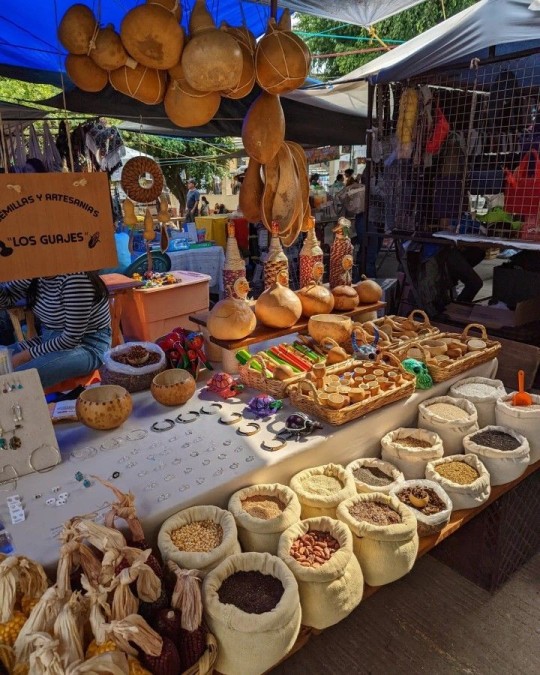
How is trade done?
Is currency universal or dictated by region?
How is your economy going? What effects it?
What trade is your world known for?
What are some exports? What must your world import?
Are any goods considered luxurious?
What services are available in your world? What services are niche?
What sort of work is common? Is work readily available?
Who is expected to work?
Are workers treated fairly or unfairly?
Are there any ways workers are protected? If not, what are some consequences?
Is your world more reliant on technology or on labour?
Is agriculture possible in your world? If so what can your people grow?
How big is industry? What goods can your people make?
What resources can your country exploit?
What are some barriers to trade and commerce?
Is your nation known for quality? Or Quantity?
Who does your country trade with most often? Who do they boycott?
Are there any major ports in your country?
Are there any banned goods? If so, is there a black market for their purchase?
Society
How society expect one to behave in public? Are there different expectations for different people/genders/ranks?
Is there a social order? Can one move up the ranks?
Is there any considerations made on account of rank, gender, age or position?
What is considered a social faux pas?
Are there any gestures or actions that are considered rude or socially unforgivable?
What would utterly shock somebody to see somebody do?
What are some opinions that are normal for your world but can be considered subversive in real life?
How can one rise up the status ladder? Is there much trouble to do so?
What denotes a person's place in society?
How is life different in cities compared to life in the countryside?
Daily life
Where would someone go to buy their weekly shop? Is food easy to come by?
What would be the daily routine of the wealthy? The common man?
How is hygiene handled in your world? Where does one go to spruce up?
What would be some day to day tasks one might face?
What is the favoured means of travel?
Are there any problems in your world that could effect a daily routine? Potholes? Gigantic spiders? Acid rain?
What ammenties would an average person expect to have access to?
Where would one go if they are injured or ill? What's healthcare like?
Do people feel safe where they live? Are there any places somebody might face danger?
How do people communicate? Is it difficult? Why?
What do people do for fun? What's considered normal fun versus hedonistic?
What pastimes are common? What kind aren't?
Is education valued?
Is there access to education? If so, for who?
Are the population educated? If so to what extent?
Family Life
What is the typical family set up?
Is extended family important?
Who can be considered family? Who can't be?
Is marriage considered a duty? Or is it more of a personal choice?
Is divorce possible?
Can people adopt children?
What happens to orphaned children?
Are children important? If not, why not? If so, why?
What are some typical toys children play with?
What are some games children play with one another?
How is in charge of household chores?
Is there a hierarchy in families?
Are children expected to take on certain roles?
What is the living situation like between the different ranks? Are the roles different?
What's considered the proper way to raise a child?
Culture and Languages
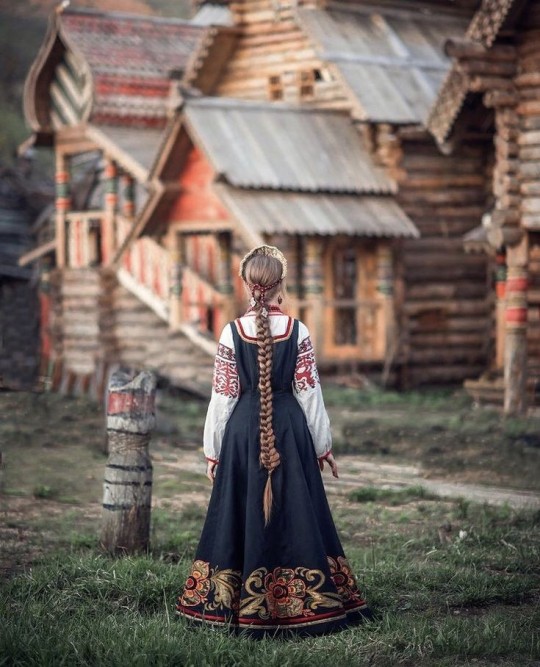
Are there multiple cultures in your world? How do they differ? Do they mesh well together?
How are cultures similar? How are they different?
Are there any traditions in your world? How important is tradition?
What are some rituals your culture undertakes?
Are there any special days? Events?
What are some traditional values in your world? Does it effect daily life?
Are there traditional clothes for your world? Are they something somebody wears on a daily basis or just on occasion?
Are there any rules around what people can wear?
What would be considered formal dress? Casual dress?
What would happen if somebody wore the wrong clothes to an event?
What languages are spoken in your world? If so, how do they sound?
Are there any dialects? If so, how do they sound?
Are most people monolingual? Or bilingual? Or multilingual?
Are there any languages that are closely related?
What is considered a universal language?
Religion

Is religion a thing in your world?
Is religion a staple of life or just a small part?
Does religion affect politics, personal lives and affiliations?
Is your world sectarian? Or ruled by religion?
What are some influences religion has on daily life?
What sort of religion is it? Monotheistic? Polytheistic?
What are some myths your people believe in?
What common rituals does one undertake on a day to day basis?
How does one please a deity?
Where do your people pray? How do they?
What symbols would denote a follower of a certain belief system to a stranger?
What places or objects are considered sacred?
Are there religious orders? If so, who can join?
Is there tolerance or violence over religion? If so, between which faiths?
Food and Drink
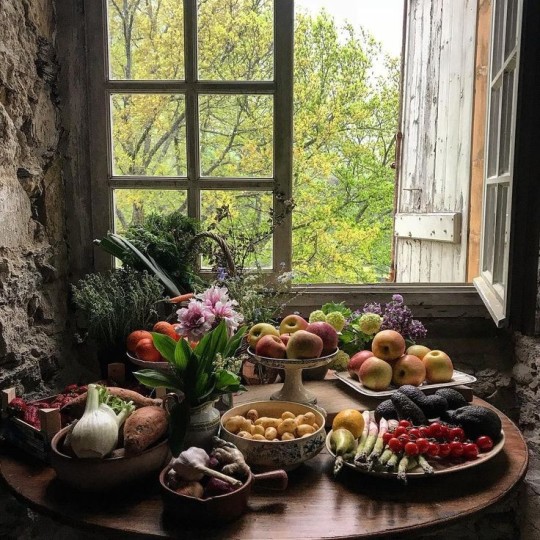
What are some traditional dishes in your world?
What would be a basic diet for the common man?
What's considered a delicacy?
Is there a societal difference in diet? What are the factors that effect diet between classes?
Is there any influence from other cuisines? If not, why not? If so, to what extent?
What would a typical breakfast contain?
What would lunch be?
What would be a typical dinner?
What meals are served during the day?
What's considered a comfort food or drink?
Are there any restrictions on who can eat what or when?
Are there any banned foods?
What stance does your world take on alcohol? Is it legal? Can anybody consume it?
Are there any dining customs? Are traditions?
Is there a difference in formal meals or casual meals? If so, what's involved?
Are there any gestures or actions unacceptable at the dinner table?
How are guests treated at meals? If they are given deference, how so?
Are there certain rules about how one can prepare food?
Are there any restrictions on eating with certain people?
How is food generally prepared by?
History
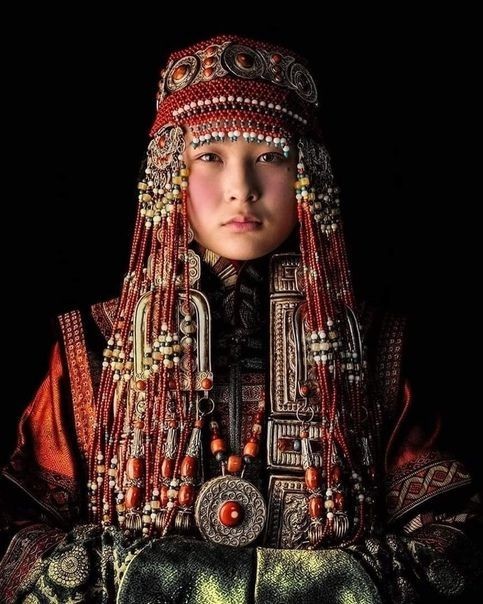
Who are some notable figures from history?
Who founded the country?
Is history looked back on with fondness? Or do your people rather forget?
Are there any heroes in history? Any villains?
What are some highpoints in the history of your land?
What are some points of history nobody likes to speak about?
Does history effect your land, people, culture, language in the present? If so in what ways?
What historic monuments are still around in the present day? What has been lost?
How do people learn about history? Do they learn the truth? Or just an abridged version?
What's a historical event that is important to the story?
#WorldBuilding Ask Game#WorldBuilding list#WorldBuilding reference#WorldBuilding research#WorldBuilding resource#WorldBuilding#writing#writeblr#writing resources#writing reference#writing advice#writers#Writing resources writing reference#Writing reference writing resources#Ask game#Writeblr ask game#writers on tumblr#spilled ink
1K notes
·
View notes
Text
a list of 100+ buildings to put in your fantasy town
academy
adventurer's guild
alchemist
apiary
apothecary
aquarium
armory
art gallery
bakery
bank
barber
barracks
bathhouse
blacksmith
boathouse
book store
bookbinder
botanical garden
brothel
butcher
carpenter
cartographer
casino
castle
cobbler
coffee shop
council chamber
court house
crypt for the noble family
dentist
distillery
docks
dovecot
dyer
embassy
farmer's market
fighting pit
fishmonger
fortune teller
gallows
gatehouse
general store
graveyard
greenhouses
guard post
guildhall
gymnasium
haberdashery
haunted house
hedge maze
herbalist
hospice
hospital
house for sale
inn
jail
jeweller
leatherworker
library
locksmith
mail courier
manor house
market
mayor's house
monastery
morgue
museum
music shop
observatory
orchard
orphanage
outhouse
paper maker
pawn shop
pet shop
potion shop
potter
printmaker
quest board
residence
restricted zone
sawmill
school
scribe
sewer entrance
sheriff's office
shrine
silversmith
spa
speakeasy
spice merchant
sports stadium
stables
street market
tailor
tannery
tavern
tax collector
tea house
temple
textile shop
theatre
thieves guild
thrift store
tinker's workshop
town crier post
town square
townhall
toy store
trinket shop
warehouse
watchtower
water mill
weaver
well
wind mill
wishing well
wizard tower
#worldbuilding#setting prompts#writer resources#writing inspiration#writing prompts#scene settings#writing reference#writing ideas#prompt list#creative writing#writing community#writer prompts#writing tips#world#fantasy world#fantasy worldbuilding#high fantasy#world building#epic fantasy#writing fantasy
2K notes
·
View notes
Text
Curated Spotify playlists to liven up your D&D sessions!
I have always loved playing D&D with background music that fits the location, mood, or type of combat, so I created several playlists on Spotify. This project is something I've been working on since December 2019, and something I want to share with you all! You can find the list below.
If you have suggestions for songs/tracks to include, or if you want a specific playlist that is not in this list yet, please let me know! And most of all, have fun!
Locations
Astral Plane
Ball/Masquerade
Bazaar
Castle/Court
City
Desert
Dungeon
Festival
Forest
Jungle
Monastery
Mountains
Schools of the Arcane
Ship
Tavern
Temple
Town/Village
Underwater
Moods
Creepy/Eerie
Dramatic
Enchanted
Energetic/Adventurous
Heroic
Grand
Intrigue
Menacing
Mysterious
Night
Peaceful
Sad/Mourning
Silly
Tender/Emotional
Combat
Small Battle
Big Battle
Boss Battle
Tavern Brawl
Chase
Themes/settings
Ancient Greece
Bard songs
Patrons/Visions
Visions/Dreams
#dnd#dnd 5e#ttrpg#music#spotify#playlist#writing#writing inspiration#spotify playlist#d&d#dungeons and dragons#worldbuilding#dm tools#resources#reference
1K notes
·
View notes
Text
A writer’s guide to the historical method: how historians work with sources
In this post, I provide a brief overview of how historians engage with different types of sources, with a focus on the mindset of a historian. This insight could be valuable for anyone crafting a character whose profession revolves around history research. It may also prove useful for authors conducting research for their book.
Concept of historical source
The concept of historical source evolves over time.
Initially, the focus was mainly on written sources due to their obvious availability. However, as time has progressed, historians now consider a wide range of sources beyond just written records. These include material artifacts, intangible cultural elements, and even virtual data.
While "armchair historians" may rely on existing studies and secondary sources, true professional historians distinguish themselves by delving directly into primary sources. They engage in a nuanced examination of various sources, weaving together diverse perspectives. It's crucial to recognize the distinction between personal recollection or memory and the rigorous discipline of historical inquiry. A historical source provides information, but the truth must be carefully discerned through critical analysis and corroboration.
Here's a concise list of the types of sources historians utilize:
Notarial source
Epistolary source
Accountancy source
Epigraphic source
Chronicle source
Oratory and oral source
Iconographic source
Diary source
Electronic source
Example: a notarial source
These are documents drafted by a notary, a public official entrusted with providing legal certainty to facts and legal transactions. These documents can take various forms, such as deeds, lawsuits, wills, contracts, powers of attorney, inventories, and many others.
Here we are specifically discussing a lawsuit document from 1211 in Italy.
A medieval lawsuit document is highly valuable for understanding various aspects of daily life because in a dispute, one must argue a position. From lawsuits, we also understand how institutions truly operated.
Furthermore, in the Middle Ages, lawsuits mostly relied on witnesses as evidence, so we can access a direct and popular source of certain specific social situations.
Some insight into the methodology of analysis:
Formal examination: historians scrutinize the document's form, verifying its authenticity and integrity. Elements such as structure, writing style, language, signatures, and seals are analyzed. Indeed, a professional historian will rarely conduct research on a source published in a volume but will instead go directly to the archive to study its origin, to avoid transcription errors.
Content analysis: historians proceed to analyze the document's content, extracting useful information for their research. This may include data on individuals, places, events, economic activities, social relations, and much more. It's crucial to compile a list of witnesses in a case and identify them to understand why they speak or why they speak in a certain manner.
Cross-referencing with other sources: information derived from the notarial source is compared with that of other historical sources to obtain a more comprehensive and accurate view of the period under examination.
Documents of the episcopal archive of Ivrea
Let's take the example of a specific legal case, stemming from the documents of the episcopal archive of Ivrea. It's a case from 1211 in Italy involving the bishop of Ivrea in dispute with Bongiovanni d'Albiano over feudal obligations.
This case is significant because it allows us to understand how feudal society operated and how social status was determined.
The bishop's representative argues that Bongiovanni should provide a horse as a feudal service. Bongiovanni denies it, claiming to be a noble, not a serf. Both parties present witnesses and documents supporting their arguments.
Witnesses are asked whether the serf obligations had been endured for a long time. This helps us understand that in a society where "law" was based on customs, it was important to ascertain if an obligation had been endured for a long time because at that point it would no longer be contestable (it would have become customary).
The responses are confused and inconsistent, so witnesses are directly asked whether they consider Bongiovanni a serf or a noble. This is because (and it allows us to understand that) the division into "social classes" wasn't definable within concrete boundaries; it was more about the appearance of one's way of life. If a serf refused to fulfill his serf duties, he would easily be considered a noble by bystanders because he lived like one.
Ultimately, the analysis of the case leads us to determine that medieval justice wasn't conceived with the logic of our modern system, but was measured in oaths and witnesses as evidentiary means. And emerging from it with honor was much more important than fairly distributing blame and reason.
Other sources
Accounting source: it is very useful for measuring consumption and its variety in a particular historical period. To reconstruct past consumption, inventories post mortem are often used, which are lists of goods found in households, described and valued by notaries to facilitate distribution among heirs.
Alternatively, the recording of daily expenses, which in modern times were often very detailed, can lead to insights into complex family histories and their internal inequalities - for example, more money might be spent on one child than another corresponding to their planned future role in society.
Oral source: in relation to the political sphere, it is useful for representing that part of politics composed of direct sources, that is, where politics speaks of itself and how it presents itself to the public, such as a politician's public speech.
However, working with this type of source, a historian cannot avoid hermeneutic work, as through the speech, the politician aims to present himself to a certain audience, justify, persuade, construct his own image, and achieve results. This is the hidden agenda that also exists in the most obvious part of politics.
Iconographic source: it concerns art or other forms of "artistic" expression, such as in the case of an advertising poster. They become historical sources when it is the historian who, through analysis, confers upon them the status of a historical source. Essentially, the historian uses the source to understand aspects of the past otherwise inaccessible.
The first step in this direction is to recontextualize the source, returning it to its original context. Examining the history of the source represents the fundamental first step for historical analysis.
Diary source: diaries are a "subjective" source, a representation of one's self, often influenced by the thoughts of "others," who can be close or distant readers, interested or distracted, visible or invisible, whom every diary author can imagine and hope to see, sooner or later, reflected on the pages of their writing.
Furthermore, they are often subject to subsequent manipulations, and therefore should be treated by historians only in their critical edition; all other versions, whether old or new, foreign or not, are useful only as evidence of the changes and manipulations undergone over time by the original manuscripts.
Electronic source: historians use Wikipedia even if they often don't admit it out loud.
This blog is supported through tips here on Tumblr. If you’d like to support me, please consider giving a tip.
#writing advice#writing help#writing reference#writing tips#creative writing#fantasy worldbuilding#fantasy writing#worldbuilding#worldbuilding tips
295 notes
·
View notes
Text
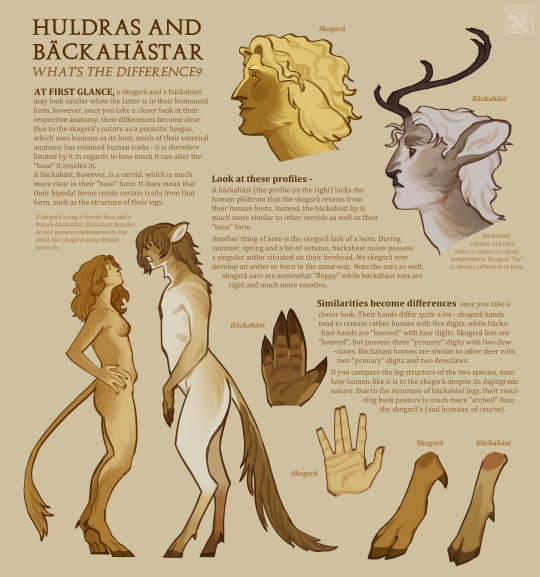
i decided to change a little bit about the bäckahäst humanoid form, and realised that they have some superficial similarities to skogsrå, so heres a thing ironing out their differences a little
#fantasy#huldra#bäckahäst#skogsrå#speculative biology#spec bio#pareidolia tag#bestiary#creature lore#lore#(huldras are referred to as skogsrå as well in pareidolia btw. or irl i guess LOL)#(skogsrå is just the regional term.... the huldra and skogsrå are very similar myths irl so its likely its the case there too)#in case ur ootl bäckahästar in pareidolia can turn into a humanoid... it has to do with the myth of näcken#(basically ppl think they are two different “creatures” but theyre actually the same just in different forms)#worldbuilding
282 notes
·
View notes
Text

First attempt at making concepts for one of my projects and presenting them in a visually appealing way. Maybe i'll edit in an english version of the text later, but for now, just plain text translation with some additions
Ysgrelian Boar - a semi-domesticated artiodactyl present in swamps and forests of Ysgrela. They are bred as an easy-to-keep, sturdy livestock, able to withstand harsh winters and find food at any time of the year. They use their showel-shaped lower incisors for digging up roots and cutting aquatic vegetation. Sexual dimorphism is represented in muzzle and tusk length. Despite their large size, they cannot be ridden, but are sometimes harnessed in carriages as status display. Ysgrelian people use not only their meat and hide, but also tusks, bones, bristles, fat, and even blood, which is sthe main ingredient of Ysgrela's national dish: black blood soup.
These boars are, in fact, closer related to hippopotamus than to actual pigs (suidae family) and cannot breed with pigs. Design is based on wild boars (main shape), tapirs (legs, snout and baby coloration), bisons (winter coat) and platybelodons (lower incisors)
Credit to Naira for helping me a lot with the sketch!
#concept art#concert#speculative biology#digital art#art#artists on tumblr#animal art#worldbuilding#reference sheet#boar#The Sun ov Man
379 notes
·
View notes
Note
So in my fantasy setting, magic not only doesn't work on iron, but applying it immediately nullifies any spell upon contact. This means that iron, in a setting with a lot of beings made of magic, is the one universal weakness that can easily kill them. Naturally, considering the fact that we're talking about a world overrun with them that are not afraid to eat people, this means societies tend to form around veins of iron ore (that's the right word, vein, right?) and are naturally going to be much more inclined to crafting iron weapons to deal with the magical beings wanting to eat people.
However, it was in thinking through that only pure iron weapons are what give iron its power that I run into issues. Considering that means steel is effectively blocked off when it comes to weapon making and magical enchantments don't work on iron here (though they do work on other kinds of metal), how exactly might that impact the tech tree on weapons in my setting? As well as anything else I might not have thought of when writing this? Thank you!
I poked at a similar thought process awhile back, and there's some problems I never fully worked around.
The problem with, “iron, but not steel,” is that, when you really get down to it, steel is just purer iron.
Let me put this another way, you're wandering around in a fantasy world that is geologically similar to our own, with similar metallurgy to 12thcentury Europe. An iron weapon you find will be mostly iron with some trace amounts of other metals such as nickle, copper, and whatever else didn't get filtered out.
In contrast, if you get your hands on a steel weapon, that's going to be almost exclusively iron, with a little carbon, maybe some phosphorus or sulfur. (There's a fairly long list of elements you can find in trace quantities, but this is also true of normal iron weapons.) The important thing to understand is, iron weapons are made from iron, steel weapons are made from better iron.
Even as far back as the first millennium, some smiths were intentionally purifying their iron to produce higher quality weapons (including the first super alloys, such as Damascus steel.) But, it was still iron.
Really, the one kind of iron you're likely to find in that world that isn'talmost exclusively iron would be meteoric iron. This is, as the name implies, iron that came from a meteor strike. In these cases, you're actually looking at a significant amount of nickle (usually 5-10%), along with a bit of cobalt and traces of a mix of other elements.This stuff was used in weapon making, but was extraordinarily rare. As a weapon, meteoric iron isn't incredibly useful, it's still inferior to steel weapons, but it will resist corrosion, and can make for a very showy weapon. This, in turn, can result in a weapon that appears to be somewhat magical, and may be while, “starmetal,” “starsteel,” or meteoric iron is a semi-popular material for magical weapons.
So, if the issue is iron itself, then there's no chemical reason steel shouldn't also function. Of course, that does nothing to eliminate potential mystical or supernatural explanations, but if this is a magical vulnerability, you're not going to find an answer in chemistry.
This leads to two possibilities. I'm going to use orichalcum as an arbitrary example, if you're unfamiliar, this was a metal Plato claimed was mined on the isle of Atlantis, and was the foundation for their economy, but you'll frequently find this brought up in fantasy without any connection to that original context.
So, either your world is one where human on human violence is conducted with something other than (and superior to) iron and steel, for example: Orichalcum, and that creates a situation where using steel weapons could actually put fighters at a disadvantage against properly equipped troops.
Alternatively, it's possible that, while iron and steel are marginally effective against monsters, there are other, much rarer, possibly irreplaceable, materials that are far more effective. In this example, it's possible that there are no sources of raw orichalcum remaining in the world, and the artifacts that have been mined and forged are all that is left. To make matters worse, it's possible that no living smiths have the knowledge to forge (or reforge) these weapons, meaning that any damage to these items is irreparable.
For an amusing twist on this, if titanium was the metal needed to harm monsters, that would create serious issues. The problem is, you cannot mine titanium. It's impossible (at least on Earth.) This is because titanium does not naturally occur as a metal, and only as an oxide (a white powder), and it wasn't until 1910 that the first metallic titanium was produced in a lab. It would be over 20 years before a process was discovered to produce it on an industrial grade. If your setting is built off of a distant apocalypse, it's possible there would be weapons produced from this material, but there would be absolutely no way to get more, while still having a veneer of chemical plausibility. (Alternately, it's possible some alchemist in the past developed a method to produce titanium in your setting... and they may or may not still be around, with the weapons being extremely difficult to produce, or signs of a lost technology.)
Actually, a fun side note, chemistry comes from the same root as alchemy, and it's a case where a pseudo-mystical field transitioned into a hard science over time.
Now, don't consider this part an indictment, but, a couple years back, I remember watching someone's, how-to: world-building on YouTube, and they blasted the concept of the, “trade city,” as semi-nonsensical. The issue is that basically any city will get its start based on trade, and really, cities live and die based on their economies. So, when you say, “this city started as a trade city,” yeah, that's how you get a city. It's the rare cities that are founded for some other reasons (like a massive fortress that gradually accumulated a civilian population of people fleeing from beyond its walls, and adventurers or crusaders using it as a last stop before moving on into the wastes, with the city, and its trade economy growing due to factors unrelated to its usefulness as a trade port.)
Now, if you're wondering how this is relevant to your question, this is about the distribution of iron. There's some discrepancies between the largest iron deposits in the real world and the distribution of people, but access to iron was a critical consideration in the development of Western Europe. Or, put another way, if you have iron mines in the hills, but farmland and a river in the lowlands, you'll probably build your city in the lowlands, on the banks of the river, and then export whatever iron and food you don't need in exchange for other goods that you do find useful. It doesn't, really, matter much if there are ravenous hellbeasts wandering the foothills, if you can dispatch them with iron weapons. All that really means is you'll have slightly less iron to export. This creates a situation where settlements may range pretty far the iron mines, if there are other economic resources worth extracting. Trade would more heavily favor access to iron than in real world history, but it's not a completely alien scenario. In some ways, this isn't that different from a continent in a permanent state of total war, the only difference is that the monsters don't need their own iron supply lines. Settlements would need to be guarded, mines, farms, and other resources would also need protection. Trade lines would need guards. The overall level of fortification may be higher than in real history (though, this isn't a certainty), but a lot of the same considerations wouldn't be affected.
Now, on a grand scale, persistent hunting by supernatural monsters would amount to a greater economic drain than witnessed in real world history. This would slow some technological, and economic growth. I'd say that cities would, likely, be more fortified, but when looking at medieval cities, I'm not sure that would be the case. I'm also not certain this would meaningfully shift the balance of power (assuming an alternate history), simply because those monsters would hit everyone roughly equally. (Though, if the monsters do play favorites, that could heavily skew the balance of power.) While access to iron would be critical, access to other trade goods such as salt, clay, grains, and other things would still be useful. The best iron mine in the world won't keep your troops fed on its own.
I doubt you'd see a situation where iron became the dominant currency metal, and too valuable to waste on coinage. You would probably still see gold and silver as the dominant metal coinage, and that would also result in some geographical skewing, as there would be some settlements built around mining gold or silver, and then selling those materials to others in exchange for iron. It's also worth remembering that for a large part of the middle ages, most coin based transactions took place at the upper echelons of society. The barter economy would still be going strong in most fantasy settings. When talking about roleplaying game settings, that does get a bit warped, as players tend to swing around extraordinary amounts of wealth.
The biggest changes I'd expect would be slightly more terra nullius. If the plains between two mountains have no mineral wealth, and the mines on either side are already well supplied, there wouldn't be much reason to settle there. You might also see a move away from river travel. Historically, this was an extremely efficient way to move large amounts of resources, but if there are monsters in the water that pose a real threat to brown water shipping, that could cause some significant changes. Settlements might be more isolated from one another initially, until technological development got to the point where overland shipping (by cart) became more viable. It might also reduce the scope of trade overall, meaning situations like the gold mining settlement above, wouldn't be able to import enough food and iron to be viable. This might also inflate the value of other, secondary, goods. For example, access to limestone deposits large enough to effectively quarry, might become a defining factor on where fortified settlements can be built. If there isn't enough limestone on site, there simply might not be a way to effectively transport more. Even if it was only 20 miles from the settlement.
At the end, how much would it change the world? I don't know. There's a lot of factors which could heavily skew how the world shakes out. It could be almost non-existent, or it could be an entirely alien world. It depends on how much pressure your monsters apply to the world.
-Starke
This blog is supported through Patreon. Patrons get access to new posts three days early, and direct access to us through Discord. If you’re already a Patron, thank you. If you’d like to support us, please consider becoming a Patron.
304 notes
·
View notes
Text
( Well Written ) dystopian worlds are NOT actually attempting to predict the future, They are a critiques of the present.
#dystopia#dystopian#dystopian fiction#my quotes#quote#quotes#writing quotes#writing inspiration#writing#writing reference#writing tips#writing ideas#quoteoftheday#quote of the day#quote of the week#quote of the night#quote of the month#quotes of tumblr#quotes of the day#worldbuilding#worldbuilding stuff#dystopian world#dystopian future#dystopian aesthetic#the hunger games#hunger games#true words#science fiction and fantasy#scifi and fantasy#tumblr quotes
151 notes
·
View notes
Text
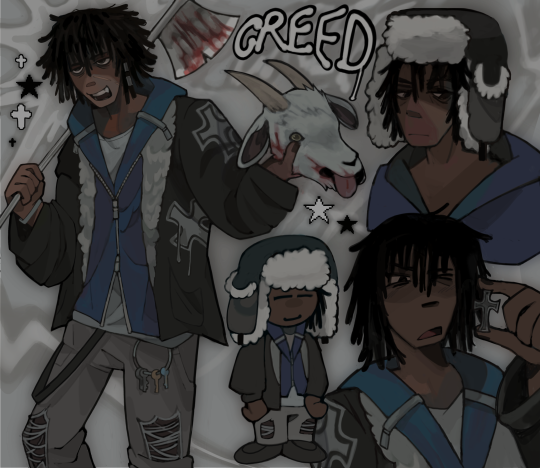
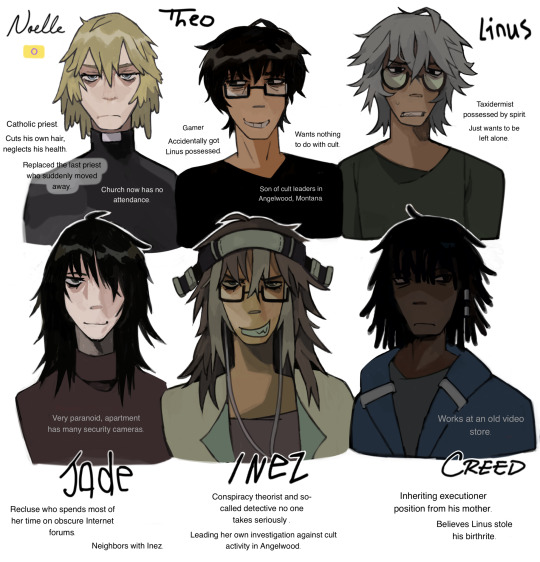

Would you believe Ive had Creed in my drafts since August thanks adventure time.
#oc#headworld things#working on it#ocs#oc art#original character#character ref#character design#worldbuilding#reference sheet#refsheet
104 notes
·
View notes
Text
Xa ontogeny

The Xa and how they grow. The brown-feathered kiddos past age of 1,5 are already able to fly somewhat. Xa don't show any sexual dimorphism, so there's only one Xa image for each life stage. Here's more about this sophont: https://www.tumblr.com/total-convergence/726112557515128832/tcxa
#speculative evolution#creature design#artists on tumblr#digital art#spec bio#spec evo#worldbuilding#speculative fiction#artwork#my art#art#reference sheet#bird art#small artist#digital artist#oc artist#drawing#illustration#scifi#scifi worldbuilding#imagination#oc art#oc#original species#speculative biology#bird oc#corvidae#magpie
114 notes
·
View notes
Text
Fantasy Guide to Building A Culture

Culture is defined by a collection of morals, ethics, traditions, customs and behaviours shared by a group of people.
Hierarchy and Social Structures

Within every culture, there is a hierarchy. Hierarchies are an important part of any culture, usually do ingrained that one within the culture wouldn't even question it. Hierarchy can be established either by age, gender or wealth and could even determine roles within their society. Sometimes hierarchy can may be oppressive and rigid whilst other times, ranks can intermingle without trouble. You should consider how these different ranks interact with one another and whether there are any special gestures or acts of deference one must pay to those higher than them. For example, the Khasi people of Meghalaya (Northern India), are strictly matrillineal. Women run the households, inheritance runs through the female line, and the men of the culture typically defer to their mothers and wives. Here are a few questions to consider:
How is a leader determined within the culture as a whole and the family unit?
Is the culture matriarchal? Patriarchal? Or does gender even matter?
How would one recognise the different ranks?
How would one act around somebody higher ranking? How would somebody he expected to act around somebody lower ranking?
Can one move socially? If not, why? If so, how?
Traditions and Customs
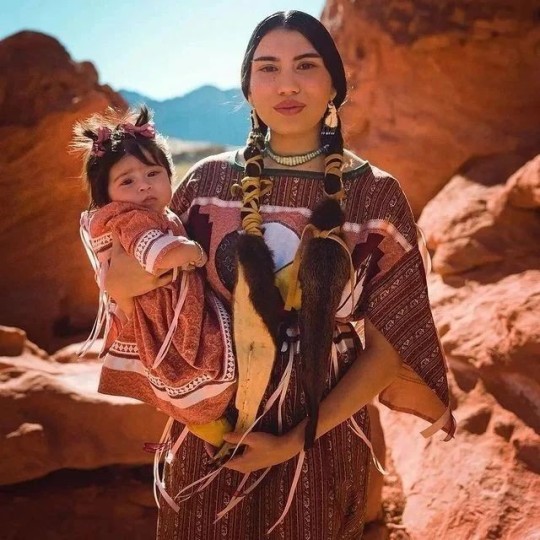
Traditions are a staple in any culture. These can be gestures or living life a certain way or to the way a certain person should look. Traditions are a personal detail to culture, they are what make it important. Tradition can dictate how one should keep their home, run their family, take care of their appearance, act in public and even determine relationship. Tradition can also be a double edged sword. Traditions can also be restrictive and allow a culture to push away a former member if they do not adhere to them, eg Traditional expectations of chastity led to thousands of Irish women being imprisoned at the Magdelene Laundries. Customs could be anything from how one treats another, to how they greet someone.
How important is tradition?
What are some rituals your culture undertakes?
What are some traditional values in your world? Does it effect daily life?
Are there any traditions that determine one's status?
Values and Opinions
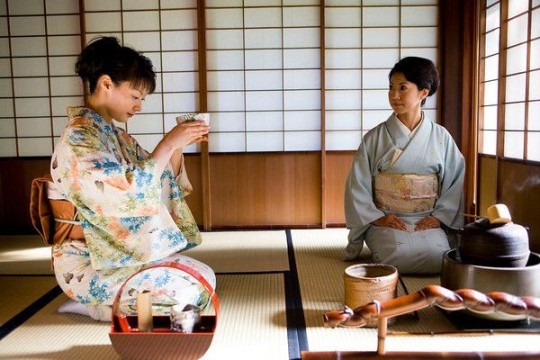
Values and Opinions are the bread and butter of any culture. This is the way your culture sees the world and how they approach different life hurdles. These may differ with other cultures and be considered odd to outsiders, what one culture may value another may not and what opinion another holds, one may not. There will be historical and traditional reasons to why these values and opinions are held. Cultures usually have a paragon to which they hold their members to, a list of characteristics that they expect one to if not adhere to then aspire to. The Yoruba people value honesty, hard work, courage and integrity. Here are some questions to consider?
How important are these ethics and core values? Could somebody be ostracised for not living up to them?
What are some morals that clash with other cultures?
What does your culture precieved to be right? Or wrong?
What are some opinions that are considered to be taboo in your culture? Why?
Dress Code

For many cultures, the way somebody dresses can be important. History and ethics can effect how one is meant to be dressed such as an expectation of chastity, can impose strict modesty. While other cultures, put more importance on details, the different sorts of clothes worn and when or what colour one might wear. The Palestinian people (من النهر إلى البحر ، قد يكونون أحرارا) denoted different family ties, marriage status and wealth by the embroidery and detailing on their thoub.
Are there traditional clothes for your world? Are they something somebody wears on a daily basis or just on occasion?
Are there any rules around what people can wear?
What would be considered formal dress? Casual dress?
What would happen if somebody wore the wrong clothes to an event?
Language
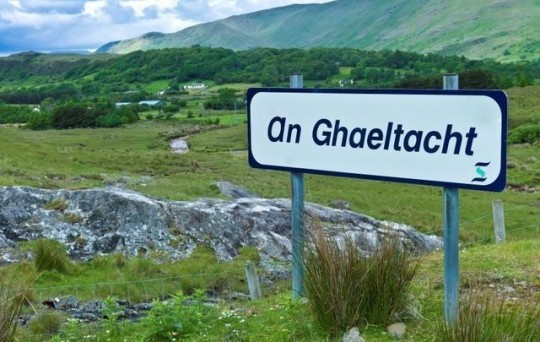
Language can also be ingrained as part of a Culture. It can be a specific way one speaks or a an entirely different language. For example, in the Southern States of America, one can engage in a sort of double talk, saying something that sounds sweet whilst delivering something pointed. Bless their heart. I have a post on creating your own language here.
Arts, Music and Craft

Many cultures are known for different styles of dance, their artwork and crafts. Art is a great part of culture, a way for people to express themselves and their culture in art form. Dance can be an integral part of culture, such as céilí dance in Ireland or the Polka in the Czech Republic. Handicrafts could also be important in culture, such as knitting in Scottish culture and Hebron glass in Palestine. Music is also close to culture, from traditional kinds of singing such as the White Voice in Ukraine and the playing of certain instruments such as the mvet.
Food and Diet

The way a culture prepares or intakes or treats certain foods are important to a culture. In some cultures, there is a diet yo adhere to, certain foods are completely banned. With Jewish culture, pork is prohibited along with fish such as sturgeon, along with shellfish and certain fowl. Meat must also be prepared in a certain way and animal byproducts such as dairy, must never be created or even eaten around this meat. This is known as kosher. The way one consumes food is also important to culture. In some cultures, only certain people may eat together. Some cultures place important on how food is eaten. In Nigerian culture, the oldest guests are served first usually the men before the women. In Japanese culture, one must say 'itadakimasu' (I recieve) before eating. Culture may also include fasting, periods of time one doesn't intake food for a specific reason.
What are some traditional dishes in your world?
What would be a basic diet for the common man?
What's considered a delicacy?
Is there a societal difference in diet? What are the factors that effect diet between classes?
Is there any influence from other cuisines? If not, why not? If so, to what extent?
What would a typical breakfast contain?
What meals are served during the day?
What's considered a comfort food or drink?
Are there any restrictions on who can eat what or when?
Are there any banned foods?
What stance does your world take on alcohol? Is it legal? Can anybody consume it?
Are there any dining customs? Are traditions?
Is there a difference in formal meals or casual meals? If so, what's involved?
Are there any gestures or actions unacceptable at the dinner table?
How are guests treated at meals? If they are given deference, how so?
#Fantasy Guide to Building A Culture#As promised#If I fail my German exam I'm blaming ye#Culture#Building a culture#Fantasy Guide#WorldBuilding#WorldBuilding guide#WorldBuilding help#Writing help#writing#writeblr#writing resources#writing reference#writing advice#ask answered questions#writers#writing advice writing resources#spilled ink#ask answered
8K notes
·
View notes
Text



welcome to Hell Froze Over!
be glad youre not there :)
we have:
Ice Spike Regions
areas covered in towering ice spikes. traveling through those regions is risky due to falling debris and strong winds.
Worm Tunnel Cities
some cities/towns are built within the ancient tunnels of ice burrowing worms. theyre generally warmer thanks to their shape, which helps with even heat distribution.
The average snowstorm (and a crash-site city)
sometimes also referred to as "the wrath of God", for uh.. obvious reasons (theyre big and scary and sooo deadly)
The Hunting Grounds
general name of areas with high Icebreaker worm activity along the equator. the ice is much thinner there compared to the rest of the planet.
Ribbon Valleys
places named after their characteristic striped icebergs.
Geothermal Areas (with stalker and flying worms)
so far only two have been discovered. theyre the only places where the ice has melted enough for the ground to be visible. unfortunately theyre also known for being worm hotspots, thus hard to access.
+ some planetary scribbly stuff & ramblings below the cut


the planet is a frozen wasteland on the surface, covered in a thick ice shell that thins around the equator, with liquid water and a (possibly) volcanic seafloor deep below. theres very little land right under the ice and the planet would be a water world with few islands scattered about if not for the extremely low temperatures.
there are a lot of unknowns about whats going on below the ice since humanity doesnt have the equipment for that kind of research and everyone is too busy trying to survive the cold.
Hell Froze Over doesnt really have seasons like our planet does since its axial tilt is minimal. instead it has pseudo-seasons caused by its elliptical orbit.
its either cold or colder. the highest recorded temperature in the habitable zone was -34°C during the "summer" season. during winter it can drop all the way down to -90°C.
#trigun#trigun stampede#vash the stampede#if you squint#hes there just tiny#ice planet au#worldbuilding#andr0art#native wildlife post coming another time#im still figuring out how worms would work here#there are a lot of ways to adapt#anyway yeah lol#worldbuilding brainrot is strong#i have so much art for this eueueuueue#i refer to it as no mans land in the notes but the name hell froze over grew on me#its such a funny fucking name for a planet#i probably forgot some stuff so i may come back later to revisit this post#or just ask if you wanna know smth
326 notes
·
View notes
Text
Official reference sheets!


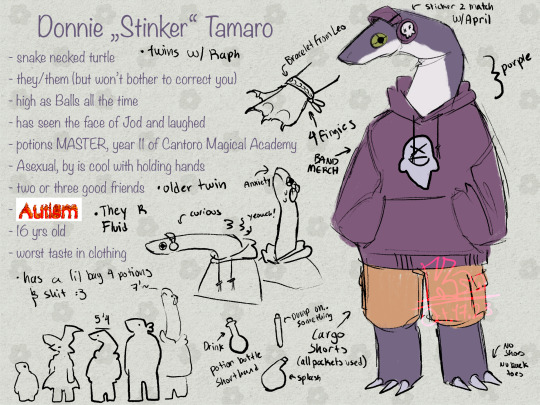
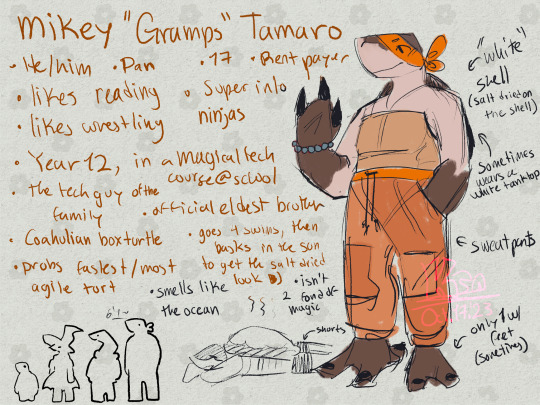
Additional notes and a transcript under the cut!
Leo „Goblin“ Tamaro
- bog turtle, he/him, 13
- likes fish (special interest)
- loves Magic and wizardry in general! Wants to become a arcane biologist (discovering and studying all sorts of magical creatures, and documenting them)
- year five of wizard school, in beginner courses
- doesn’t like change all too much
- thinks aquariums are the best (they are)
- uses a wand to cast his spells (ninpo) because it’s safer for beginners to channel their magic through a conduit to reduce chance of pain to the user
- Color is a dark blue, similar to a deep ocean color
(Side Note, i don’t have a lot for Leo yet and I feel really bad about it :()
Raph „princess“ Tamaro
- painted turtle, she/her, 16 and younger twin to Donnie
-mean transfer and she thinks gender is stupid
- bisexual
- witch, loud AND proud
- year 11 of magic school, in a spells course and working on getting her certificates to use magical equipment, the only one with a magic broom license and uses it to her advantage
- has and uses a magic broom to get everywhere she can reasonably use it, her Ninpo is related to the summoning of magic fire familiars (I’ll explain at a later date)
- although she can be mean and sarcastic at times, she is a caring older sister to all of her family
- she’s also a gamer, enjoys run and guns and has the best style, bows are her favorite
- hot pink is her color
Donnie „Stinker“ Tamaro
- snake-necked turtle, they/them but won’t bother to correct you, 16 older twin of Raph
- high as Balls all the time
- saw the face of Jod and laughed (refuses to call Jod anything other than Jod)
- potions MASTER, and year 11 of Cantoro Magicks academy (name is subject to change)
- asexual, but is cool with holding hands, only has 2 - 3 good friends
- A U T I S M
- worst taste in clothing by far
- makes their own potion bottles, and has a small bag they made themselves to store said potions
- gender-fluid
Mikey „Gramps“ Tamaro
- Coahulian box turtle, he/him, pan, 17 (tax payer)
- likes reading and wrestling, thinks ninjas are the best
- was never good at magic (ninpo), ended up being super good at magic tech though (ended up becoming the tech guy of the family as a result)
- year 12, in a magic tech course for learning how to handle/make magical equipment
- very serious about his ninja training, and keeps himself in shape by exercising (his fav is swimming around, because he can bask in the lamp right after and it feels SO good) ((also gives him a salt-dried look, and a white shell from the salt))
- likely the fastest or most agile of all of them
#art#my art#smiles doodles#rise of the tmnt#rottmnt au#sorta#it’s more of a worldbuilding expansion into the mystic side of things#anyways#the extracurriculars#Mikey tmnt#Donnie tmnt#raph tmnt#Leo tmnt#tmnt au#magic au#kinda#again it’s more of an expansion or extension#rottmnt#long post#art reference#character reference#(s)
143 notes
·
View notes
Text
Worldbuilding through cultural anthropology series – #0 What is culture?
This series aims to serve as a guide for worldbuilding centered around culture and its various components, based on the theories of cultural anthropology.
To start, let's understand what culture is. Anthropologically, we define culture as the set of acquired abilities and habits shared by a group of people; the elements of this set are called cultural facts. Culture does not encompass behaviors linked to the instinctual sphere of humans.
What are the basic facts of culture?
It is holistic, meaning that each fact must be interconnected with the others. In other words, every cultural fact should have an explanation that links to another and does not contradict it.
It is dynamic, selective, and adaptive. It means it is not immutable and does not stratify over time; instead, it changes, modifies, and adapts to the surrounding environment and historical period. Some cultural facts may be lost and thus extinguish due to adaptation. Generally, cultural facts persist when repeated over time.
It is operational, meaning it includes ingrained and automated habits and behaviors, as well as worldviews (these automated cultural facts make up a habitus [what is habitus?]).
In a globalized world, it has blurred boundaries. Cultural facts can be shared, and differences between one culture and another are subtle.
It is maintained through transmission. As we mentioned, cultural facts are acquired, and transmission is the process that allows the acquisition and maintenance of cultural facts in generations, along with forms of memorization and externalization of memory (mythologies, proverbs, poetry, etc…).
Transmission can be:
Explicit: a parent directly teaching a behavior to a child or sharing a worldview.
Implicit: a child observing their mother peel potatoes in a certain way and learning to perform the same actions by imitation without explicit instruction.
When creating your cultural group, consider these fundamental traits for every aspect of its culture.
What are the cultural facts considered by anthropology nowadays?
Worldview
Cosmogonies/cosmologies
Religions
Magical systems and beliefs
Categories and forms of judgment
Values and symbols
Corporeal systems
Production systems
Settlement systems
Livelihood systems
Power systems
Social relationship systems
Forms of memorization and externalization of memory
We'll explore some of these as we continue with this series.
This blog is supported through tips here on Tumblr. If you’d like to support me, please consider giving a tip.
#wbtca#Worldbuilding through cultural anthropology#worldbuilding through cultural anthropology#writing reference#writing help#writing tips#writing advice#creative writing#worldbuilding#worldbuilding tips#fantasy worldbuilding#fantasy writing
98 notes
·
View notes
Text

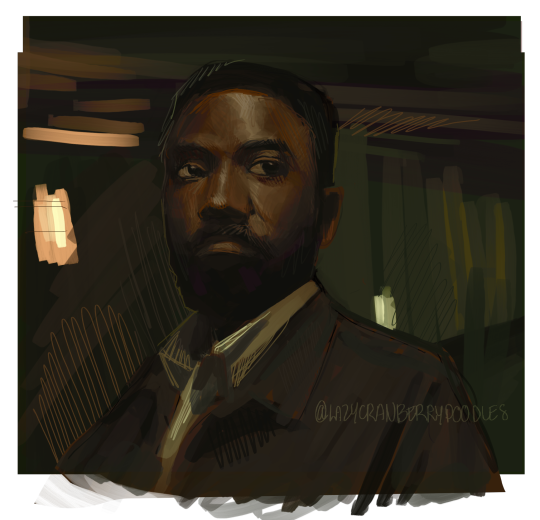
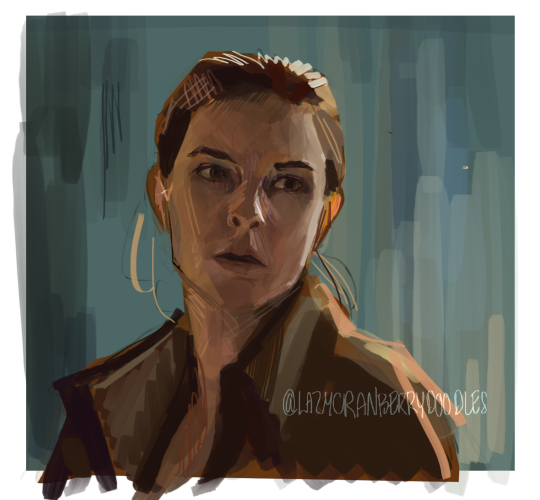
portrait practice with SILO characters rahhhh (for each i tried to work from reference as much as i could and then switched to tracing so that they Looked Right.)
#juliette nichols did unthinkable things to my mind and body (reference to bigtop burger: kid)#you know the post about scifi being sweaty women in tank tops covered in dirt. yeah#the silo writers: ok so theres an antagonist who wears all black. and is the only one in universe to do so. and he has big beautiful eyes#they visited the 'My Favorite Character factory' and stole the secret recipe. i feel so catered to#the main character is a grimy autistic engineer with tattoos (for the first 2 episodes. then she gets a new job 😔) and i love her a lot!!!#its a mystery scifi. it's not what i usually watch but the worldbuilding was really good#you could tell the set and costume design had a lot of love put into them#and the plot was intriguing to follow#do i recommend silo?#yes. its a good show :)#these are portrait practices from august. faces are still currently my least favorite thing to draw but they are slightly easier now#silo#silo apple tv#art#my art#silo fanart
131 notes
·
View notes
Text



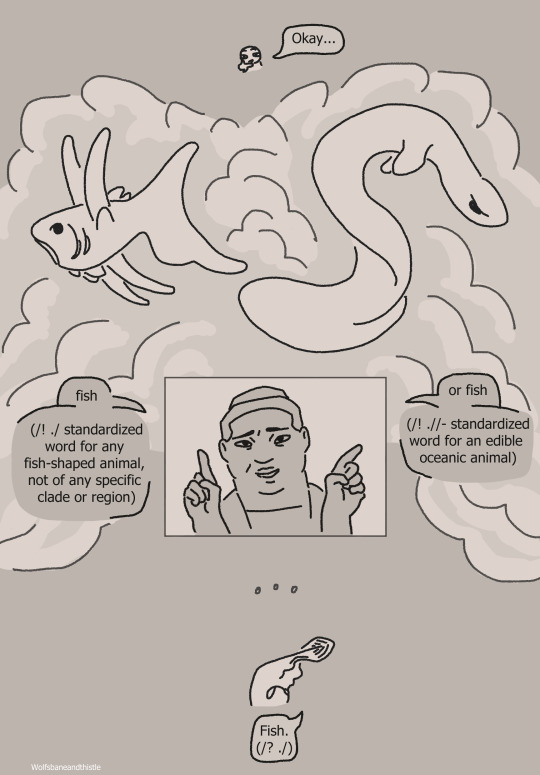

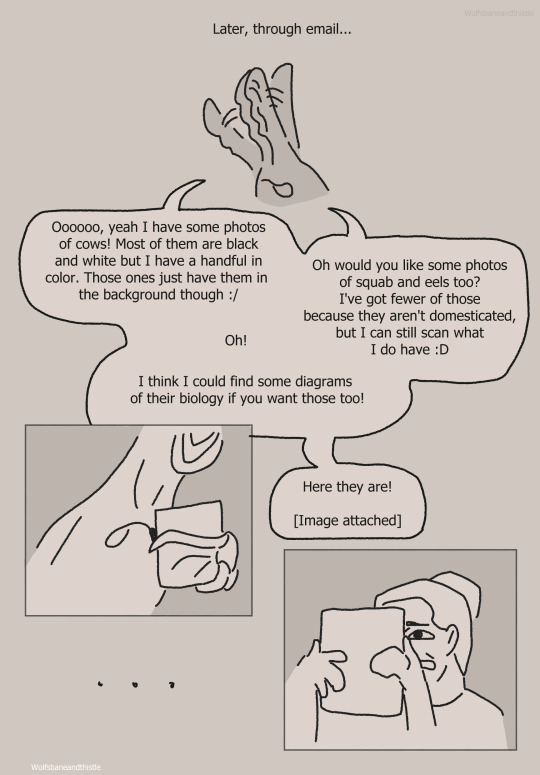

Notes on food, fish, and translation errors.
Hán and Ankiusk are good friends, but during the time that they’re getting their medical certifications they’re both still learning the Galactic Standardized language. That combined with Ankiusk’s lack of a jaw to make the click (!) letter, there are a lot of communication issues.
And I mean… what do you call an alien animal in an alien language so that a third alien can relate it to yet another alien animal. Language may be evil but comparative xenobiology is even more so.
#I very nearly didn’t finish this.#I started it months ago#hated it. wound up abandoning it#picked it up again. still months ago. redid everything and liked it quite a bit more#but ended up leaving it again#THEN I picked it up a third time. did the reference sheets for my human characters. and was finally able to finish the lineart.#I don’t even know when I actually started it#my program says I made it prior to the preventative and repetitive care notes.#So it’d be sometime in August/September. Jesus Christ.#damn#sci-fi#spec bio#speculative biology#xenobiology#worldbuilding#little bird worldbuilding#my art#oc: hán huì qún#oc: ankiusk#medical textbook images to get tormented by#long post#comic
63 notes
·
View notes